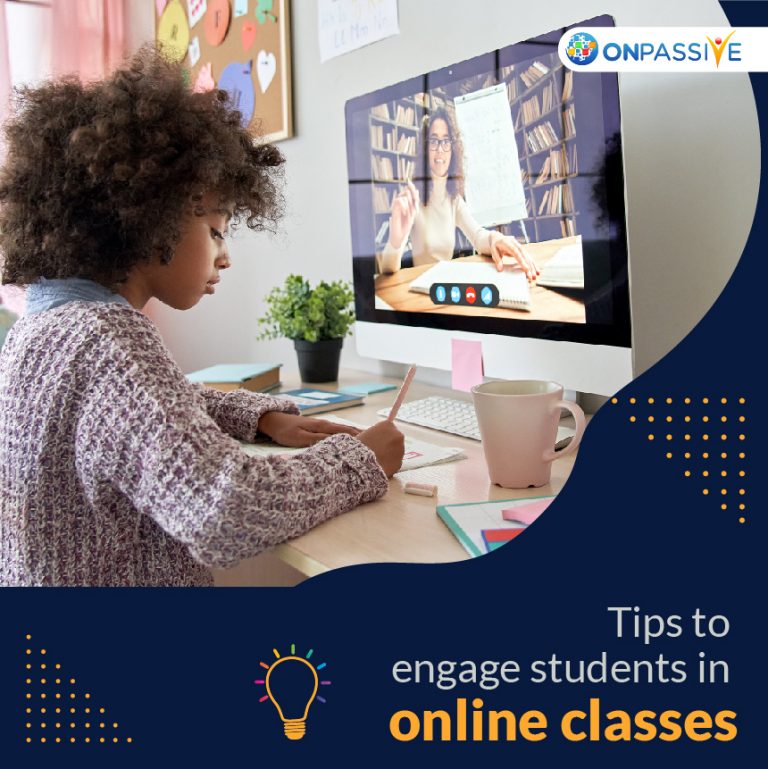
With the outbreak of Covid-19, many governments declared the closure of schools and colleges, thereby allowing them to operate remotely. This resulted in the transition of the education system in the past year, with all the schools and colleges conducting online classes.
The transition of classes from classroom to online is challenging for both students and teachers and a new experience. However, teachers need to put in extra efforts to engage students as there are high chances of distractions at home.
Many teachers had to make a switch in teaching with little or no experience of online teaching. Student engagement has become paramount for a high-quality learning experience. Therefore, teachers need to develop new ways of engaging students to ensure high quality of online learning experience.
Tips for engaging students in Online Classes
Keeping students engaged increases student satisfaction while enabling them to be motivated to learn more, reducing the sense of isolation thereby improving student performance.
Here are few tips to ensure high-quality student engagement during online classes:
- Communicate in Multiple Formats
Online classes provide multiple communication modes for instructors to communicate with students. Although emails and discussion forums are standard communication tools for online classes, audio and video chat rooms, broadcast text messaging, and instant messaging are the latest technologies to communicate with students about e-courses. Students tend to receive explanatory screencast videos well and are increasingly being adopted by many instructors to keep students engaged.
- Giving students a sense of ownership and control
Providing students with a choice in assignments allow them to dive deep into specific topics. Self-assessment is another opportunity that helps them understand their skills and allow them to improve their skills by understanding where they are lacking. Own experiences improve the knowledge of content and learning experience of students.
- Improve the course accessibility
Problems with web accessibility can cause problems in the way classes are conducted and reduce student engagement. Taking minor steps towards improving the accessibility of course materials works well for educators to engage students on a frequent basis.
- Regularly update Course Content
Differentiating online courses by updating them with the latest content is crucial for online classes. Teachers can regularly update the course content with the latest research and development, news, policies and regulations, opinions, articles, videos and podcast episodes, conference recordings, and emerging trends that make it attractive to students by ensuring that you are not delivering stale content to students. The course content needs to be relevant and timely to hold the student’s interest and attention.
- Provide timely and valuable Feedback
Feedback on students performance is essential to keep students engaged throughout the journey of online classes. Providing a quick response to email questions and discussion posts allows students to track the next activity or assignment. Grading of assessments will have a direct impact on the future efforts of students. Providing valuable and timely feedback can be more effective than unclear messages.
- Make Learning Social
A sense of classroom community can be created among students over social platforms when utilized effectively. Many instructors are using social media to spice up their course content and how classes are conducted online to engage students on topical learning. Adding a Twitter badge to the course’s homepage and then using a hashtag with course relevant content can interest students and help them be actively engaged with that specific topic or content.
- Encourage Accountability
Instructors can schedule and send automated emails to students who don’t log in to classes for a specific time or days or those who won’t complete their work on time by leveraging the email notification feature in their learning management system. Teachers can also keep a check on students periodically, while the check-ins can also get feedback. These emails help generate a sense of accountability in students, which is very important.
- Try new tech-tools
With continuous development in technology, it is an excellent time to use new tools and self-discovery. Some educational technologies and tools are quick and easy to use in online space and are engaging. With proper research, instructors can choose the best tool that actively engages and interacts with students.
The instructors’ efforts to improve the overall learning experience of students will let them understand and engage in the online classes and more likely to be motivated to learn more.
Conclusion :
Keeping the students engaged in online classes is one of the most promising ways of student retention in the coursework. Instructors need to develop exciting ways to design online courses and implement student-centred learning to engage students with all the course topics or subjects. A creative learning environment and online activities encourage the cognitive engagement of students in online classes.


